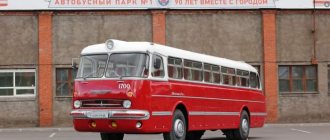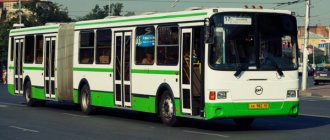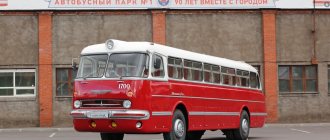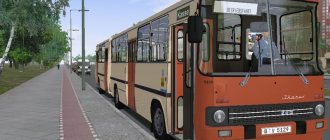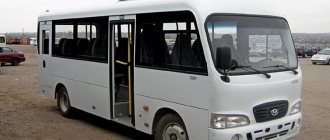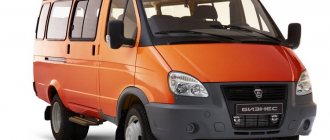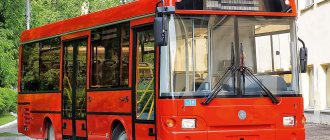Home Brands MAZ MAZ-103
The Belarusian MAZ-103 is a low-floor (floor level 360 mm) large-class bus, whose task is to transport passengers in urban areas. The production of buses at the Minsk plant began in 1992, when the company signed a licensing agreement with one European bus manufacturer. The first models were built entirely from imported parts, which greatly inflated the price of the buses. The company's managers decided to combat this by introducing components of their own production, simplifying the design and adapting it to the surrounding realities.
All this led to the presentation of a new model in 1996; the number of imported parts in the bus did not exceed 8%. The bus was produced in its original form until 2006, when it was restyled.
Review of the MAZ-103 bus
The Belarusian MAZ-103 is a low-floor (floor level 360 mm) large-class bus, whose task is to transport passengers in urban areas.
The production of buses at the Minsk plant began in 1992, when the company signed a licensing agreement with one European bus manufacturer. The first models were built entirely from imported parts, which greatly inflated the price of the buses. The company's managers decided to combat this by introducing components of their own production, simplifying the design and adapting it to the surrounding realities. Content:
All this led to the presentation of a new model in 1996; the number of imported parts in the bus did not exceed 8%. The bus was produced in its original form until 2006, when it was restyled.
Design and dimensions of MAZ-103
The bus body is load-bearing and all-metal, and has a carriage type structure. Both the roof and sides of the bus are entirely made of solid metal sheets, while the front part is made of fiberglass. Together with glued glass, this creates optimal body rigidity with a high degree of safety for passengers.
The design type can also be called carriage style. The front part of the bus is represented by a small bumper, in the corners of which small “rounds” of fog lights are integrated, and above them, with a decrease in size, there are several more separate “rounds” of low and high beams and turn signal indicators. The windshield is split in two at the center with a large wiper blade for each side. At the very top of the MAZ-103 there is a large electronic route indicator board with replaceable route signs.
In profile, the bus has extended wheel arches, large side mirrors with a vertical orientation, there is also another route indicator board in the upper part, and the window sill line rises closer to the rear.
The rear part is mainly covered with a solid sheet of metal, there is a false radiator grille and rear optics similar to the front lights.
Dimensions correspond to the class and have the following values:
- Length is 11,985 mm;
- Width – 2,500 mm;
- The height is in the range – 3,120-3,400 mm;
- Distance between axles – 6,140 mm;
- Total weight – 18 tons.
The car is available in two versions. The first is intended for urban use, and the second for suburban use.
Greetings from passengers
The completely low floor is great. Especially when the potential buyer knows what he wants. Alas, not everything is so smooth with the MAZ-205. It is clear that the expensive modern car was primarily aimed at rich cities, among which Moscow, naturally, was in first place. It was by order of the Muscovites that the folding ramp for strollers was placed opposite the 2nd door (they say, everyone is so used to it), and there... That’s right, the engine “shaft”, you need to turn 90° immediately after entering and, squeezing through a passage of 760 mm, get into a small storage unit for one stroller. On the first copy, the Minsk residents showed an alternative - the 3rd door there also had a ramp leading to a “dance floor” of 15 m2, but, probably, they failed to convince the customer of the feasibility of such a move, and on the second car, only 2 had a folding ramp. th door. And in light of the fact that the only pair of seats not on the podium is located right next to the 3rd door, the phrase “customer care for the disabled” cannot be written except in quotation marks.
Younger people will enjoy the bus much more. Four full double doors, without any steps, quite comfortable chairs with large (from 250 to 360 mm) legroom. The slight variety of seats is due to the fact that the seats for older people, there are six of them, are equipped with armrests and have a different color. Convenient handrails throughout the cabin are at hand, and unlike some competitors, you don’t have to check their strength with your own head. Even a first-grader can use the stop buttons placed on them, and it is almost impossible to accidentally press them.
The only thing I didn't like was the mentioned layout of the rear of the trailer. It seems that the Mazovians immediately designed this part on the basis that there might not be a 4th door, and its place would simply be taken by two more rows of seats. If this is so, then everything is logical, but if not, then no. Even if the load on the 3rd axle forces the number of passengers to be artificially limited in this way, then the podiums could be partially abandoned. Personally, I am not consoled by the thought that, due to the stoves hidden under the floor, you have to overcome a 340 mm step and, I believe, many will agree with me, because from a low-floor bus you expect not only smooth passages.
But there should be no questions about the stuffiness in the cabin, for which the first generation of Mazov buses is notorious. A forced ventilation system has now been added to the ceiling ventilation hatches, and the narrow folding window loopholes have been replaced by large sliding windows. Yes, and tinted windows perform their functions. So, despite some controversial issues, the overall impression of the bus is positive.
Cabin interior
The bus cabin is very spacious and comfortable. For boarding and disembarking, three all-glass doors are used, each of which is 1.2 meters wide. The seats in the MAZ-103 are made of plastic with fabric upholstery. There is a heater and ventilation system. Air conditioning can also be installed as an option. The driver's seat has soft filling and support that is pronounced for bus seats. All controls are within arm's reach. The instrument panel does not have a pronounced visor, and all sensors and indicators are located on a flat surface.
Depending on the modification, the bus is capable of carrying a different number of passengers at a time. The urban version has 19-30 seats and a total of 82-98 seats.
The suburban modification is equipped with 28-39 seats, and the nominal capacity is 83-96 people.
Equipment
The base model is equipped from the factory with two rows of seats. There are double chairs on the left and single chairs on the right. The all-welded frame is resistant to vertical and torsional loads. Cars of recent years of production are equipped with Mogilev single-chamber double-glazed windows with ultraviolet-reflecting coating. Thanks to this, a comfortable temperature is maintained in the cabin in the summer.
The MAZ-105 bus is equipped with the following options:
- automatic shock absorbers that level the body when there is a difference in load and when driving on an inclined road;
- tinted windows that block solar radiation;
- plastic seats resistant to impacts and sharp objects;
- ceiling fans that remove polluted air from the cabin when idling in traffic jams;
- LED board broadcasting information about the route and advertisements;
- plastic handles located at different heights, convenient for tall and short passengers;
- automatic fire extinguishing system, activated without human intervention;
- interior heater with thermal barrier on the doors.
The manufacturer produces school buses with two rows of seats and a reinforced frame. For the needs of public utilities, mobile toilets are produced, which go to crowded places on city streets and squares.
Specifications
The power range of MAZ-103 engines is varied. Available configurations include both turbocharged diesel inline-six engines and gas-powered engines, which are also available in 6-cylinder versions.
Diesel power units are equipped with a modern Common Rail fuel injection system, and depending on the modification, the engines meet Euro-5 and Euro-6 environmental standards.
German-made diesel engines Mercedes-Benz OM906LAG and OM926LAG are available with different volumes, power and torque:
- Volume 6.4-7.7 liters;
- Power 285-320 hp;
- Torque – 1100-1300 Nm.
The gas engine develops from 279 to 302 hp and torque ranges from 1000 to 1200 Nm.
All this power is digested by Allison, ZF and Voith Diwa automatic transmissions, which distribute it to the rear wheels. The maximum speed, depending on the engine type, is 93-105 km/h.
Chassis - shock absorbers with two elastic elements are installed in front, and a spring system with four air springs is installed in the rear. All MAZ-103 brakes have disc mechanisms and a pneumatic drive, and the steering is equipped with a hydraulic booster.
History and description
After a “pilot” batch of four dozen MAZ-101 buses was assembled, Minsk residents began preparing the improved “ 103 ” model. The portal rear axle installed on the MAZ-101 was replaced by a new bridge design, similar to the design of the bridge on trucks. This led to an increase in the step in the rear door (there are no steps in the other two doors), but had a positive effect on the price, reliability and maintainability of the bus. Externally, the MAZ-103 differs from the MAZ-101 in the absence of a route indicator window on the left side (driver’s side). MAZ-103 is a semi-low-floor bus - its floor level in the front part (360 mm) rises only from the middle door to the engine compartment to 580 mm.
The body of the MAZ-103 bus is load-bearing, all-metal, carriage type. The sides and roof are made of seamless galvanized steel sheet, the front part is made of fiberglass. The glass is glued in and, as a rule, tinted. Side windows can be installed with either narrow folding windows or wide sliding ones. The bus has three sliding doors (two double doors for passengers and the rear half of the front door, the front half of the front door for the driver). Door openings - 1250 mm. The driver's cabin is fenced off from the passenger compartment as standard. In 2004, for operation in Moscow, by order of the Moscow government, a modification of the MAZ-103 was produced, in which the front door leads completely into the passenger compartment. The driver's cab door was located on the “cabin-salon” partition.
The passenger compartment of the MAZ-103 has expanded somewhat compared to the MAZ-101, in particular, the distance between the left and right rows of seats has increased. The bus usually has a three-row layout. On the left side there are double seats. On the starboard side - single. Seats - from 21 to 28 depending on the configuration, the total (nominal) passenger capacity is 100 people, maximum - 123 passengers. The cabin has a storage area opposite the middle door. The engine compartment is located in the rear left corner of the cabin and occupies the entire space from floor to ceiling.
The total weight of the MAZ-103 bus is 18,000 kg, including the load on the front axle - 6,500 kg, on the rear - 11,500 kg. The 220-liter fuel tank is installed in a niche on the right side along the bus and is attached to the body frame with clamps.
Initially, YaMZ-236 and MMZ D-260.5 engines were installed on the buses. However, due to low power, noise and vibration load, very large mass and dimensions, the Yaroslavl engines on the MAZ-103 did not last long. Externally, buses with a YaMZ engine can be recognized by the engine compartment, which occupies a large width in the cabin. Subsequently, the MMZ-260.5 engine with a power of 230 hp. became the most popular on Minsk low-floor buses - this configuration of the bus was designated MAZ-103-002.
The full set of engines ever installed on the MAZ-103 is as follows: a series of MMZ D-260.5 engines (in-line six-cylinder, 7.12 l, 230 hp, 70 km/h), Renault MIDR 06.02.26X (inline six-cylinder, 226 hp), Renault MIDR 06.02.26Y41 (inline six-cylinder, 6.18 l, 250 hp, 90 km/h), Mercedes-Benz OM 906 LA (inline six-cylinder, 6.37 l., 231 hp., 80 km/h), MAN D 0826 LOH-07 (in-line six-cylinder, 6.6 l, 230 hp., 90 km/h), MAN D 0826 LOH-15 (in-line six-cylinder, 220 hp), Deutz BF6M 1013EC (7.146 l, 237 hp, 78 km/h).
In addition to the basic version, the plant also developed special versions of this bus - MAZ-103-065 with a ramp for wheelchairs, MAZ-103-075 "Arctic" in the northern version. MAZ-103-075 is easy to distinguish due to the reduced area of the interior glazing (due to the modified shape of the side windows, there is no broken line characteristic of conventional 103s) and a high level of interior insulation. In the front low-floor part of the bus, all the seats are located on pedestals, inside of which there are additional heating stoves. To preserve heat in the cabin, the floor is made of double layers, the roof has additional thermal insulation, and the heating of the driver's cabin has been improved. Until recently, the distinctive feature of “northern” buses was the Deutz diesel engine, but it has also begun to be installed on ordinary city buses. Buses with this diesel engine can be identified by the exhaust pipe on the roof.
In 2004, a completely low-floor MAZ-103N65 was assembled in a single copy. Other differences include air conditioning, no windows, and an all-passenger front door. The bus was exported to Romania.
The most common modifications of the MAZ-103 city bus: MAZ-103-002 Engine MMZ-D260.5-27, gearbox Praga 5PS 114, MAZ-103-003 Engine MMZ-D-260.5E2, 155 hp, EURO 2, Gearbox ZF S6-85 MAZ-103-041 Engine Renault MIDR 06.02.26Y41, gearbox Praga 5PS 114.57 MAZ-103-060 Engine Mercedes-Benz OM 906 LA ll/2 EURO 2, 231 hp, automatic transmission Voith Diwa D 851.3E MAZ-103-061 Engine Mercedes-Benz OM 906 LA ll/2 EURO 2, 231 hp, gearbox ZF S6-85 MAZ-103-062 Engine Mercedes-Benz OM 906 LA lll/2 EURO 3, 231 hp, gearbox ZF S6-85 MAZ-103-065 Engine Mercedes-Benz OM 906 LA lll/2 EURO 3, 231 hp, automatic transmission Voith Diwa D 851.3E MAZ-103-067 Engine Mercedes-Benz OM 906 LA lll/2 EURO 3, 231 hp, gearbox ZF S6-85 MAZ-103-070 Engine Deutz BF6M1013EC, gearbox ZF S6-85 MAZ-103-075 Engine Deutz BF6M1013EC, gearbox Voith Diwa D 851.3E
Technical characteristics of the bus: Overall dimensions, mm 11985 / 2500 / 2835 Base, mm 6140 Floor height on the middle door platform, mm 360 Outer turning radius, no more than, mm 11300 Wheel track (front/rear), mm 2045/1825 Permissible load on the front axle, kg 6500 Permissible load on the rear axle, kg 11500 Gross weight, kg 18000 Number of seats, people (depending on configuration) 1, 24, 25, 28 Nominal (maximum) capacity, people 100 (123) Maximum speed, km/h 70-90 Suspension front/rear axle independent/dependent pneumatic Rear axle rigid beam with double spaced gear Disc wheels 8.25×22.5 Tire size 11/70R22.5
MAZ-103 served as the basis for a whole family of buses: the commuter MAZ-103S
Technical characteristics of the MAZ-103S bus: Overall dimensions, mm 12000/2500/2838 Base, mm 6140 Floor height on the middle door platform, mm 360 Height of steps above road level, mm 340 Outer turning radius, no more than, mm 11300 Wheel track (front/ rear), mm 2046/1825 Permissible load on the front axle, kg 6500 Permissible load on the rear axle, kg 11500 Gross weight, kg 18000 Number of seats 34, 35, 36 Nominal capacity 90 Maximum speed, km/h 113 Engine Mercedes- Benz OM906LA (E3, E4)/Deutz BF6M 1013 (E3) Engine power. kW (hp) 170(230)/174(237) Gearbox manual/automatic ZF/Voith Diwa Front/rear axle suspension independent/dependent pneumatic Rear axle rigid beam with double spaced gear Wheels 8.25×22.5 Tire size 11/ 70R22.5
MAZ-103 also became the basis for the platform bus (distinguished from the city bus in the reduced number of seats), mobile public toilets MAZ-163 . In addition, trolleybuses were created: MAZ-103T (produced directly at MAZ), ETON-MAZ-103T (produced by Eton LLC, Smolevichi, Minsk region since 2008), AKSM-221 (produced by Belkommunmash , PT-6231 (manufactured in one copy by PetroTrolleybus (St. Petersburg) with an eye to deliveries to St. Petersburg, but lost the tenders), Ganz-MAZ-103T (a completely low-floor trolleybus, made in two copies by a Hungarian trams and trolleybuses, was developed with an eye to the tender in Riga. The project was closed due to the bankruptcy of Ganz Transelektro).
In April 2008, the Minsk Automobile Plant presented a restyled version of the bus - MAZ-103-465, a photo of which can be seen in the gallery.
In 2005, the Minsk Automobile Plant and the Nizhny Novgorod industrial group Samotlor-NN began joint production of the MAZ-103 bus. The final assembly of the buses took place at the production facilities of this company in the city of Semenov (Nizhny Novgorod region). The first “Samotlor” buses MAZ-103 “Stolichny” entered the city routes of Nizhny Novgorod at the end of 2006. They differed from the standard MAZ-103 with a modified front mask, modular light optics from Hella and an electronic route indicator in the form of a running line. The interior has also undergone a significant modernization: the design of the handrails, lighting and heating systems have been changed, anti-vandal seats have appeared, and the layout has changed. When passing Russian certification, these buses received their own index “ MAZ-5295 ”.
After 2 years - in 2007 - at the Moscow International Automobile Salon, the Samotlor-NN group demonstrated another option - a city school bus. It made it possible to accommodate 46 students and three accompanying persons in the cabin through the use of child seats with reduced dimensions. The bus is equipped with warning signs and other paraphernalia of a “school carrier” in accordance with GOST standards.
